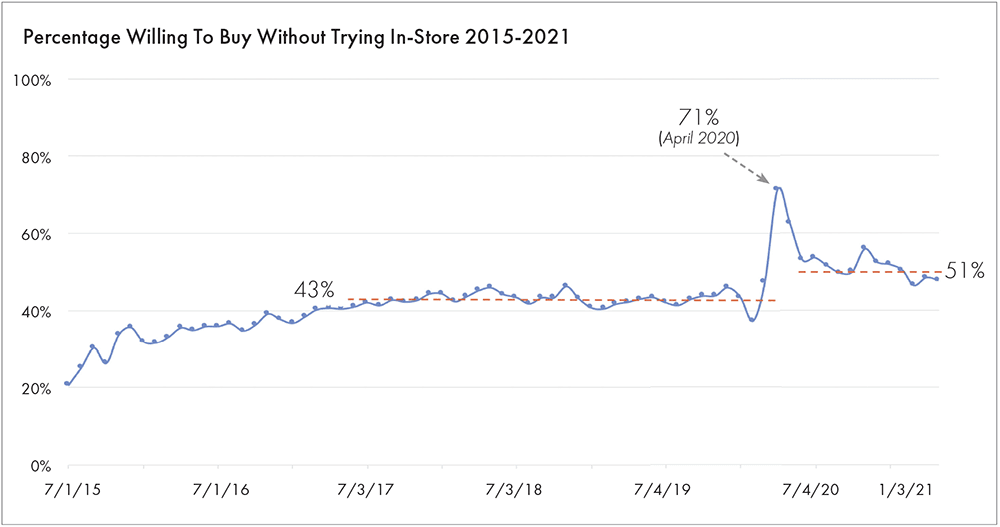
Recent proprietary data from the website GoodBed.com points to long-term opportunities as well as threats for mattress retailers.
Editor's Note:This article is based on Episode three of the ‘Mike It Up’ podcast (www.mikeitup.com), which provides mattress retailers with critical strategic insights based on consumer data and trends.
Long after our lives return to a sense of normalcy, the impact of COVID-19 on the mattress shopping journey will remain. Over the past year, the mattress industry has witnessed an unexpected boom in demand. Instead of the usual postponing of large discretionary purchases that befall the mattress industry in most recessions, house-bound consumers have increased their spending on home-related goods including big-ticket items like mattresses. But amidst this overall surge, which has certainly lifted most boats in the industry, it can be easy to miss the ways in which COVID has transformed the mattress shopping journey for consumers. These changes are likely to remain long after the quarantine-driven nesting trend has passed—and will have a critical impact on what mattress retailers need to do to succeed long term.
Tracking a Key Metric
Thousands of readers each month tell us whether they need to try their bed in a store before they buy it.
|
At GoodBed.com, we’ve been quietly tracking a key consumer metric for nearly six years. In the ordinary course of using GoodBed to shop for a mattress, thousands of readers each month tell us whether they need to try their bed in a store before they buy it. We first started collecting this information in the third quarter of 2015, a little over a year after Casper launched. Had we started before Casper’s launch, this percentage would have certainly been in the single digits. And by mid-2015, it had already risen to nearly 20 percent.
Over the next three years, the portion of people willing to buy without trying continued to rise steadily. Fueled by this rapidly expanding addressable market, 150 new online mattress brands flooded the market—a rate of one new brand per week. Meanwhile, brick-and-mortar retailers started to feel the impact of changing consumer preferences. Mattress shoppers were visiting fewer stores as part of their journey—with some visiting none at all—and the average store’s foot traffic fell as a result.
43%—A Saturation Point
In early 2018, the music finally stopped. The line that had been moving up and to the right since the dawn of the online mattress revolution suddenly flatlined at 43 percent. At this exact same time, the number of online mattress brands peaked. For the first time, the number of brands going out of business surpassed the number entering the market. Meanwhile, the largest online brands were quick to notice (or anticipate) this change, responding with headline-generating brick-and-mortar expansion plans that picked up vast amounts of steam in 2018 and 2019. Though our metric bounced around by a percentage point or two from month to month, the line remained stubbornly flat at 43 percent, making it clear that consumers’ willingness to buy a mattress without trying it had reached a saturation point.

The Impact of COVID
By early 2020, consumers’ willingness to buy without trying had been locked at the same level for over two years. Then suddenly, as news of the pandemic’s first wave swept across the country, this percentage skyrocketed. In March, when the pandemic first hit home for most of us, it hit a new high of 48 percent. In April, it shattered that high, reaching 71 percent. By May, fears had subsided a little, and by summer and fall, the number had settled back into a steady range once again—only now, the portion of consumers willing to buy without trying had risen to over 50 percent—where it’s stayed ever since.
On top of this, we’ve also seen a profound change in the portion of the consumer journey that happens online. Before the pandemic, we were already seeing upwards of 90 percent of mattress shoppers doing online research. But many of those people still relied on store visits for a large part of their education, product discovery, comparison and purchase decision. In the post-COVID world, all of these activities have moved increasingly online. Our data suggests that more consumers are using the internet to identify and research the products that interest them, leaving the ultimate store visit, if any, to simply confirm that the product they chose online meets their expectations. Likewise, many retailers have reported to us that since the pandemic began, consumer visits have tended to be more perfunctory or confirmatory in nature than before.
As more consumers want and expect to do their mattress decision-making online, you need to provide
richer online information about your products and services.
|
How Lasting Will These Changes Be?
While the long-term impact of COVID remains to be seen, there is good reason to believe that many pandemic-induced behavioral changes will have a lasting effect. This tends to be particularly plausible in cases where:
-
Such behavioral changes were merely an acceleration of a pre-existing trend (e.g., increasing use of online shopping or food delivery services).
-
Consumers discovered unexpected benefits of adopting alternative shopping strategies during the pandemic.
The impact of COVID on mattress shopping could arguably fit either or both of these criteria. Although it had plateaued, the increasing willingness to buy without trying was nonetheless a well-established trend that was well underway before COVID. Likewise, as shoppers were forced to do more of their information gathering and decision-making online, they discovered information sources and conveniences that they had not previously anticipated. Now that the public is more aware of these advantages, expectations of being able to shop this way are much more likely to remain.

GoodBed.com is a personalized guide for mattress shopping. The website makes it easier for readers to make the best choice by providing trustworthy and dependable guidance based on expertise + data + technology.
|
What this Means for Retailers
In mattress retail, driving store traffic has always been the name of the game. Historically, physical location has played a huge role. Stores with highly visible signage at high-traffic intersections or in busy shopping centers have been very successful. This worked because consumers were heavily reliant on store visits to learn about their options and make purchase decisions.
In a post-COVID world though, consumers are completing more of their product discovery, research, and decision-making before (or without) ever setting foot in a store. As their journey moves increasingly online, high-traffic locations in the physical world become less important. What matters instead is that stores are visible on the ‘virtual street’ that shoppers travel. Consumers use a multitude of online resources to research this purchase. That’s why, as a mattress retailer, your stores need to be found in as many of these places as possible—especially the online resources where consumers are likely to be making decisions about what to shop and buy. As a retailer, you can’t deliver a great experience if the consumer never finds you.
Website Messaging Strategy
Beyond this change in advertising strategy to direct traffic to your website, it’s become increasingly important to review the messaging on your website. As more consumers want and expect to do their mattress decision-making online, you need to provide richer online information about your products and services. Take a step back and think about all reasons shoppers make an in-store purchase from you. Then, make sure that they get as much of this information as possible from your website. Likewise, you’ll also want to focus on making your website easy to use. In monitoring the many reviews, questions, comments, and inquiries received from consumers on GoodBed.com during COVID, we’ve noticed reports of challenges navigating bedding retailers’ websites—especially from older consumers who are newer to online shopping. This means that ease of use is more important, and more valuable than ever before.
Conclusion
While COVID’s daily impact on our lives will eventually pass, its legacy on shopping behavior will remain. With more shoppers willing to buy without trying, and the remaining people expecting to do more of their decision-making online, retailers must adapt if they hope to thrive and survive. Of these adaptations, by far the most important are re-orienting your advertising to make sure that active mattress shoppers find your website and that you provide the right kinds of information there to help them feel confident in making a mattress selection and purchase from you.